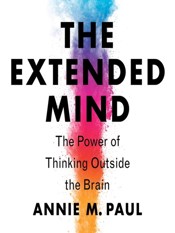The Extended Mind: The Power of Thinking Outside the Brain

This is an interesting look about all the ways we think and process information other than the neurons and synapses in our brains. To be fair, we don’t really think outside the brain, but external stimuli help us process information in ways we don’t often realize.
Each chapter covers a way think:
- Thinking with sensations
- …Movement
- …Gesture
- …Natural Spaces
- …Built Spaces
- …the Space of Ideas
- …Experts
- …Peers
- …Groups
There’s lots of science in here, and lots of anecdotes. Quite a bit of it was both interesting and natural – I found myself nodding my head and thinking, “Yeah, I can totally see that.”
For example, the chapter on “natural spaces” makes the point that our brains like (1) congruence and (2) redundancy, and nature offers both. An open field is congruent – nothing is out of place – and redundant – it goes on and goes. This has a calming effect on our brain.
There’s also quite a bit of good practical advice in here. I’ve started taking a quick walk around the block in the morning, without my phone, because quiet time through the outdoors helps reset me.
My wife is a kindergarten teacher. She was fascinated by some of the information about gestures and indoor spaces. Kids, in particular, are wildly affected by what’s around them. Adults too – if you’re responsible for an indoor space, like an office or church, there’s some good practical advice.
I enjoyed it. It made me think differently about thinking and all the inputs that go into it.
Book Info
- I have read this book. According to my records, I completed it on .
- A hardcover copy of this book is currently in my home library.